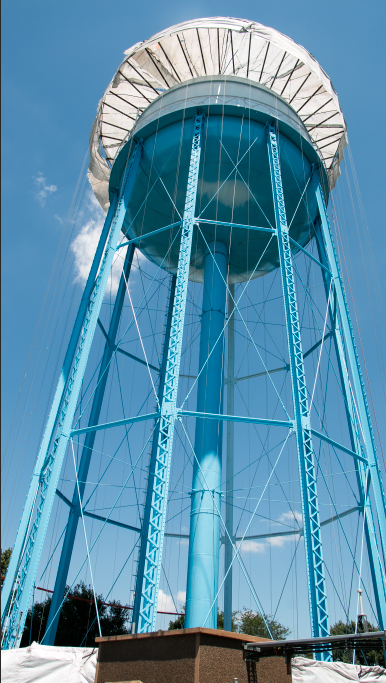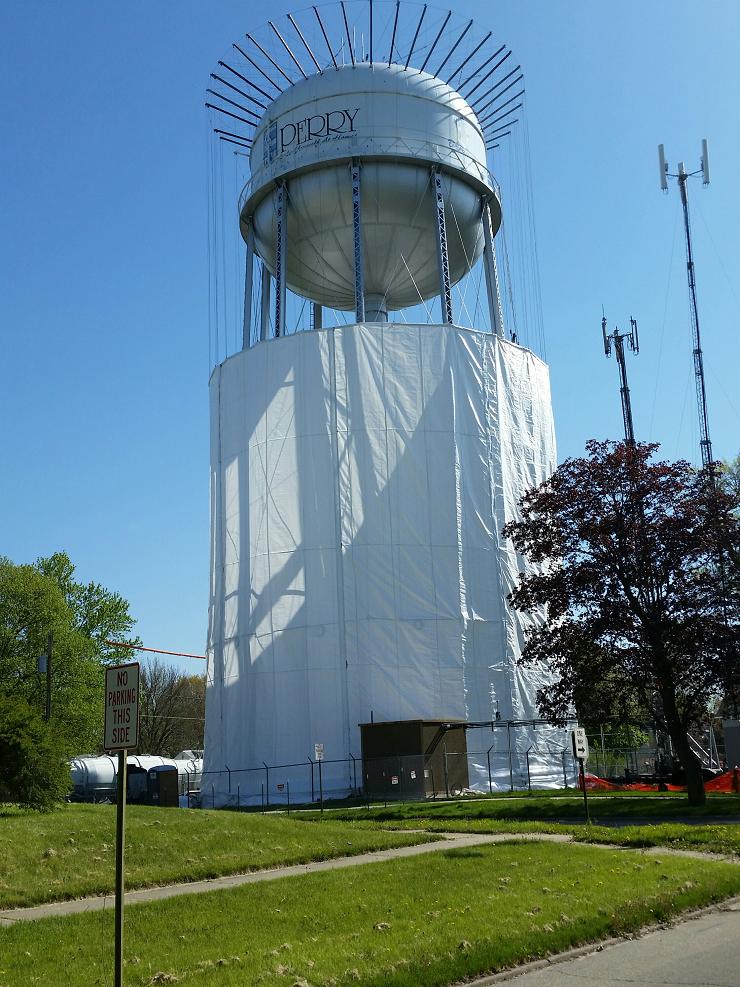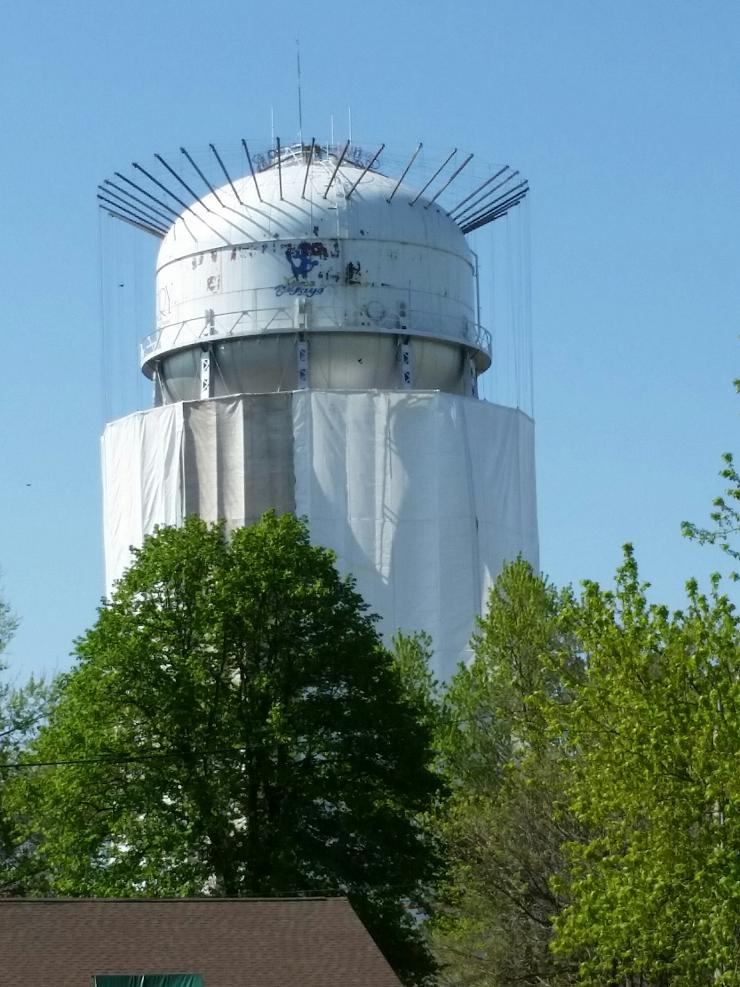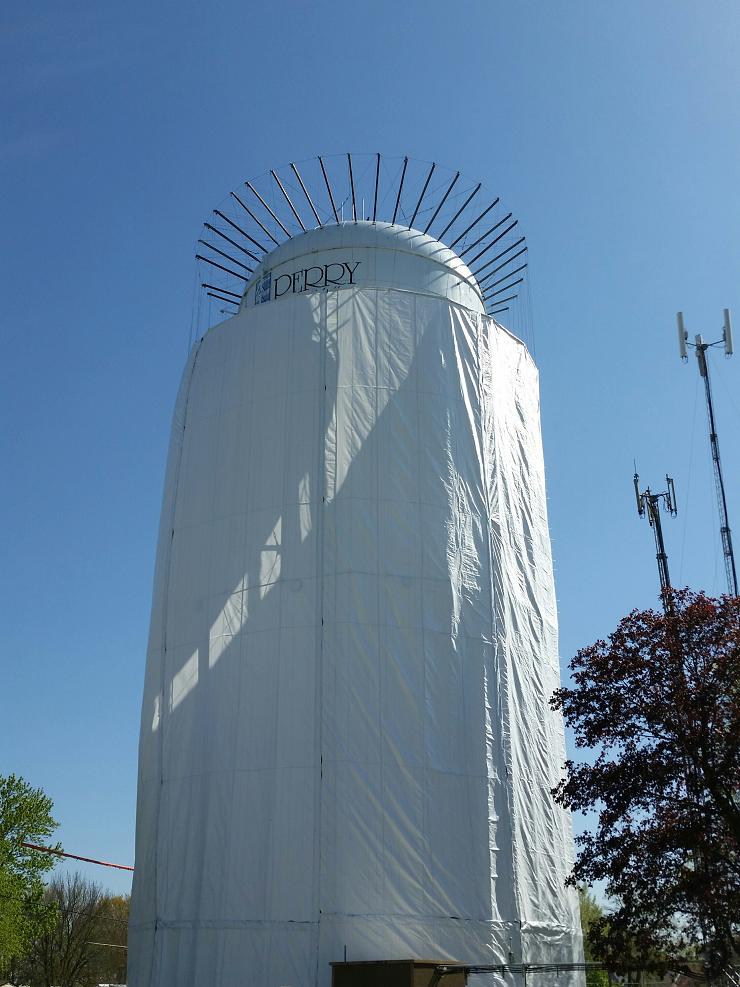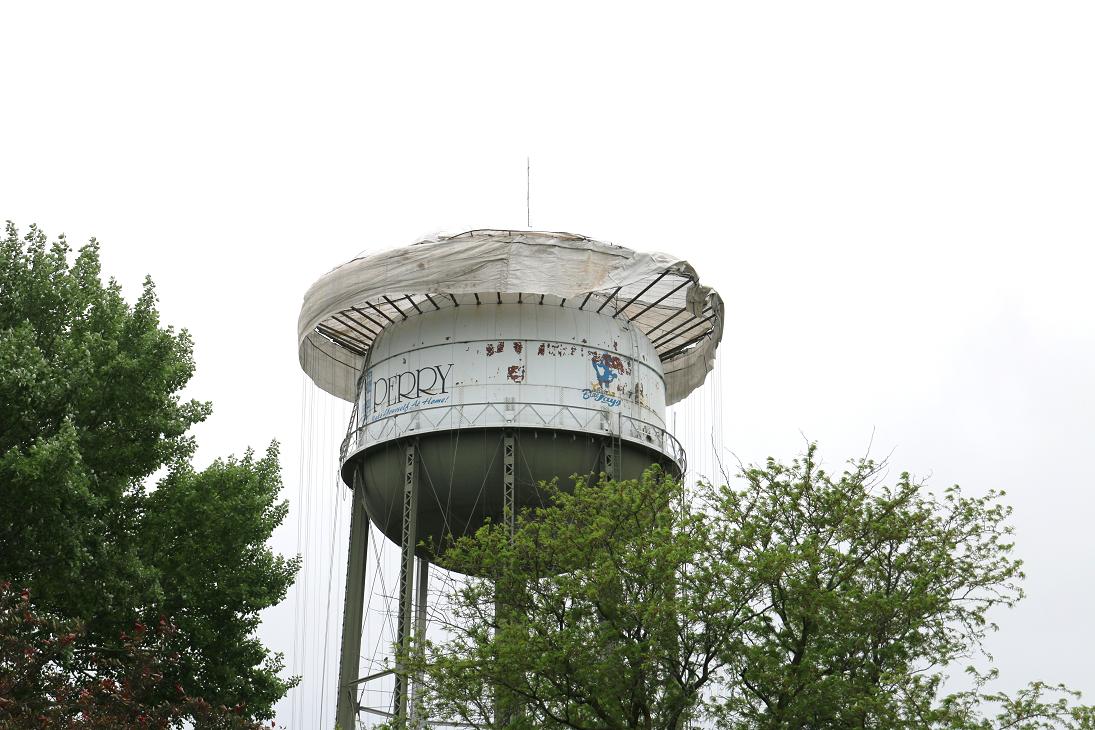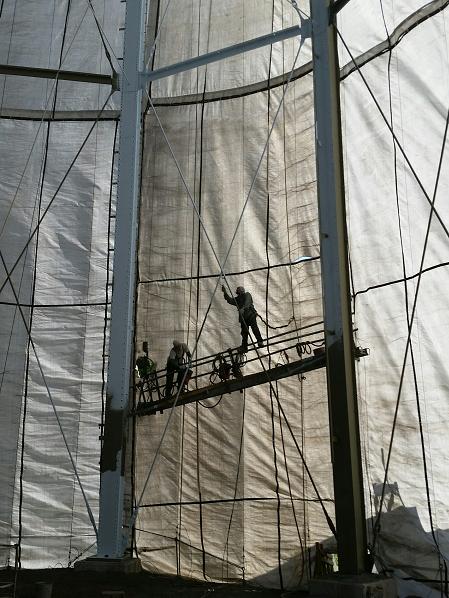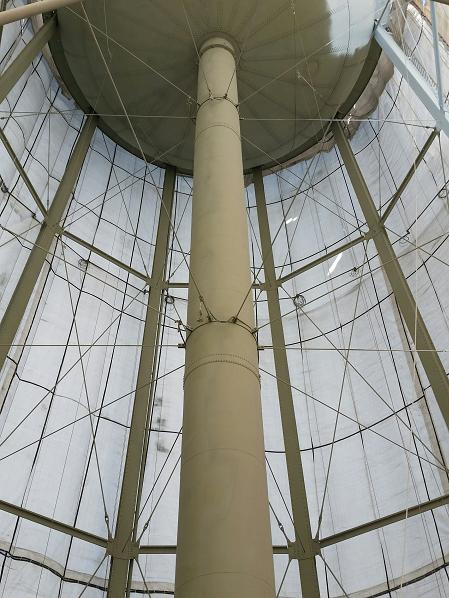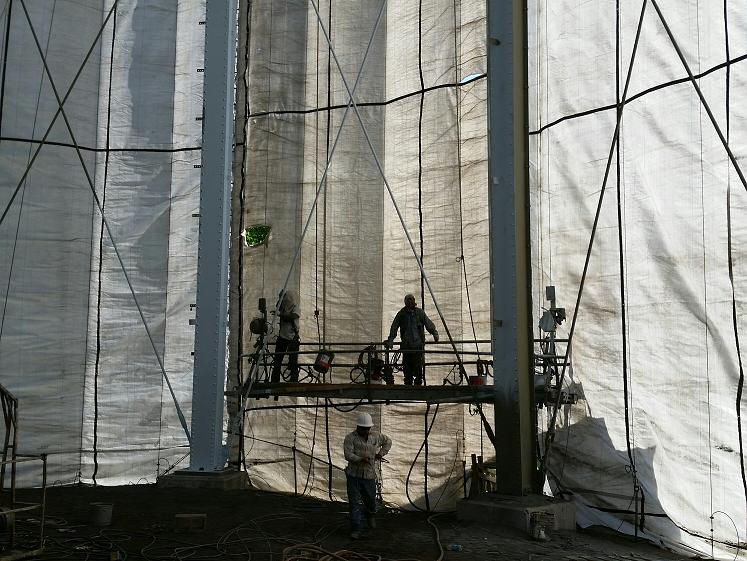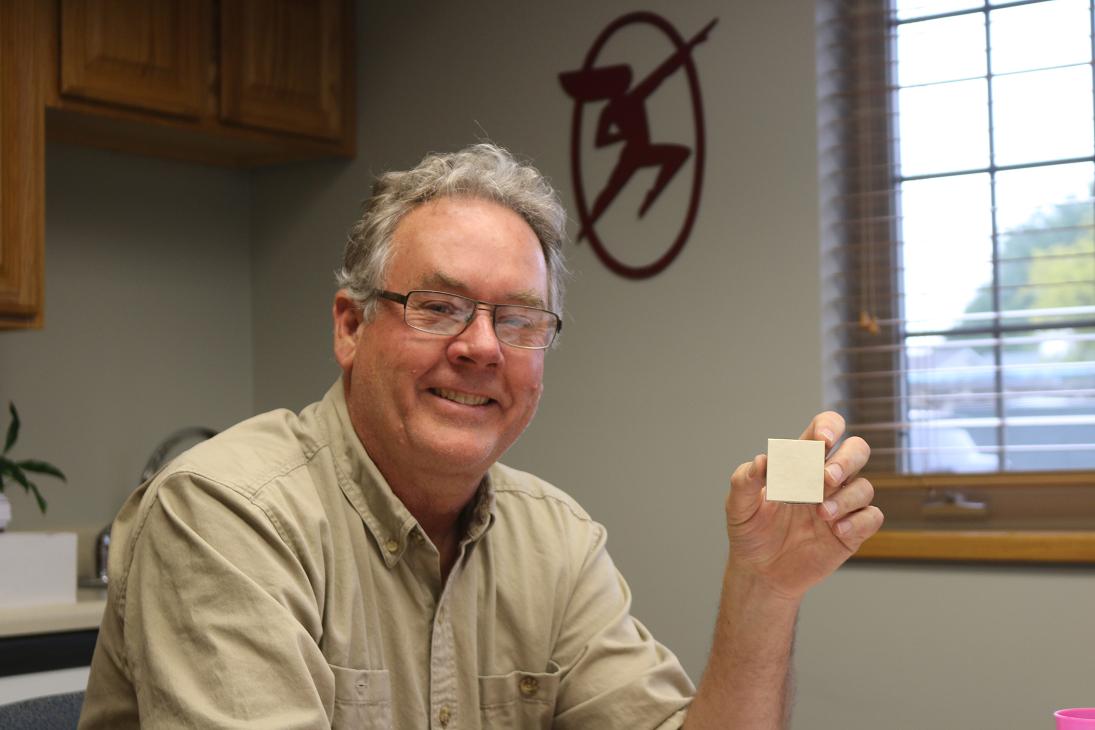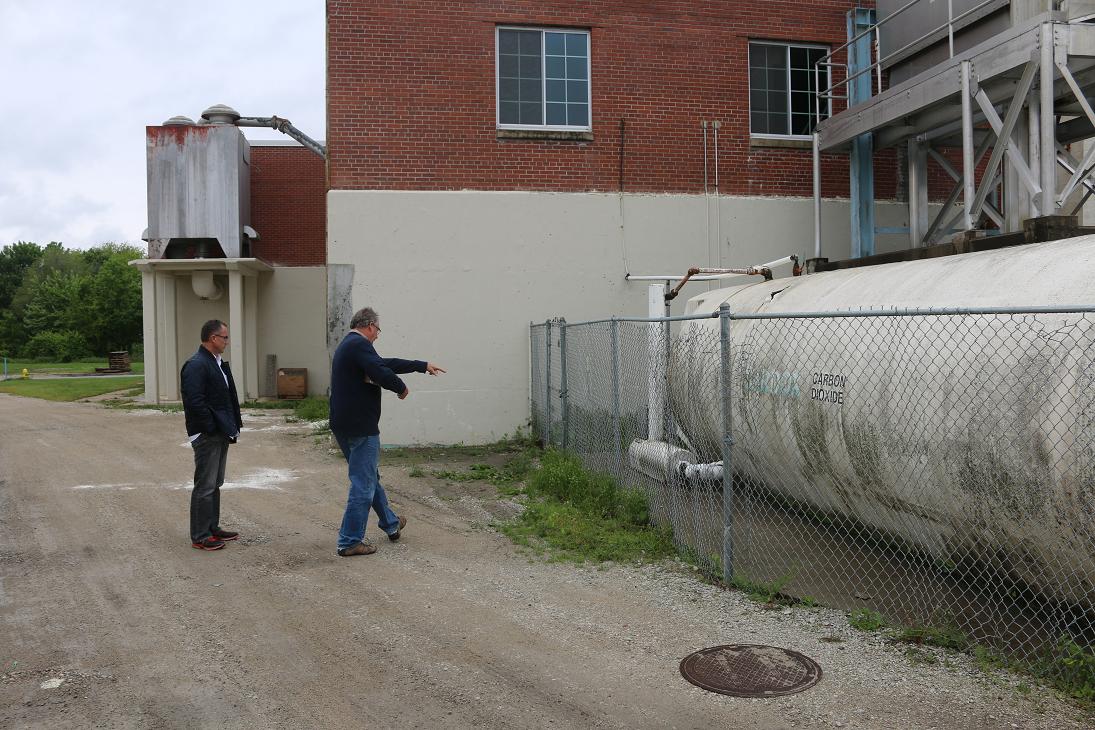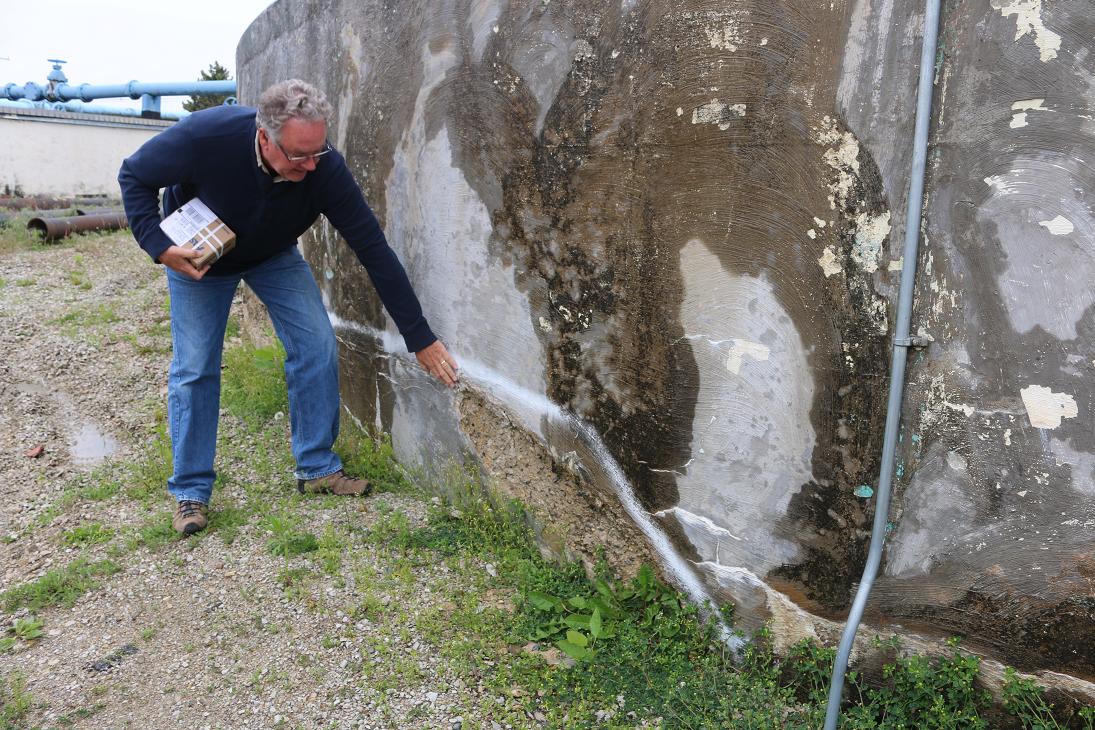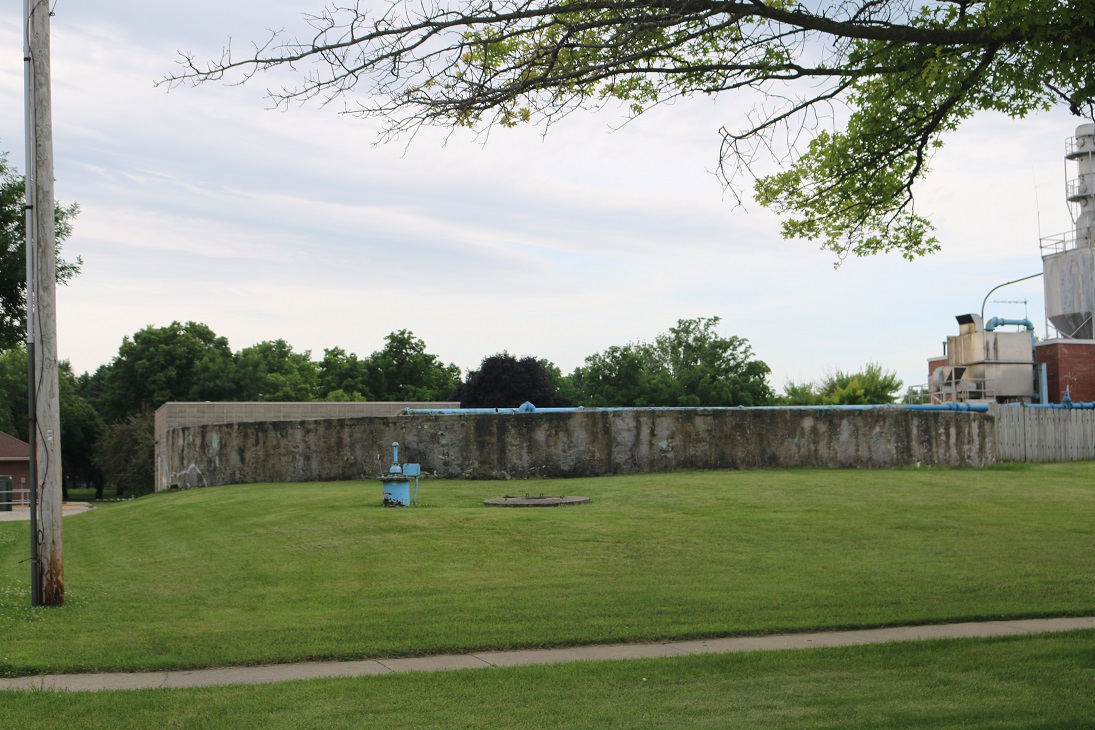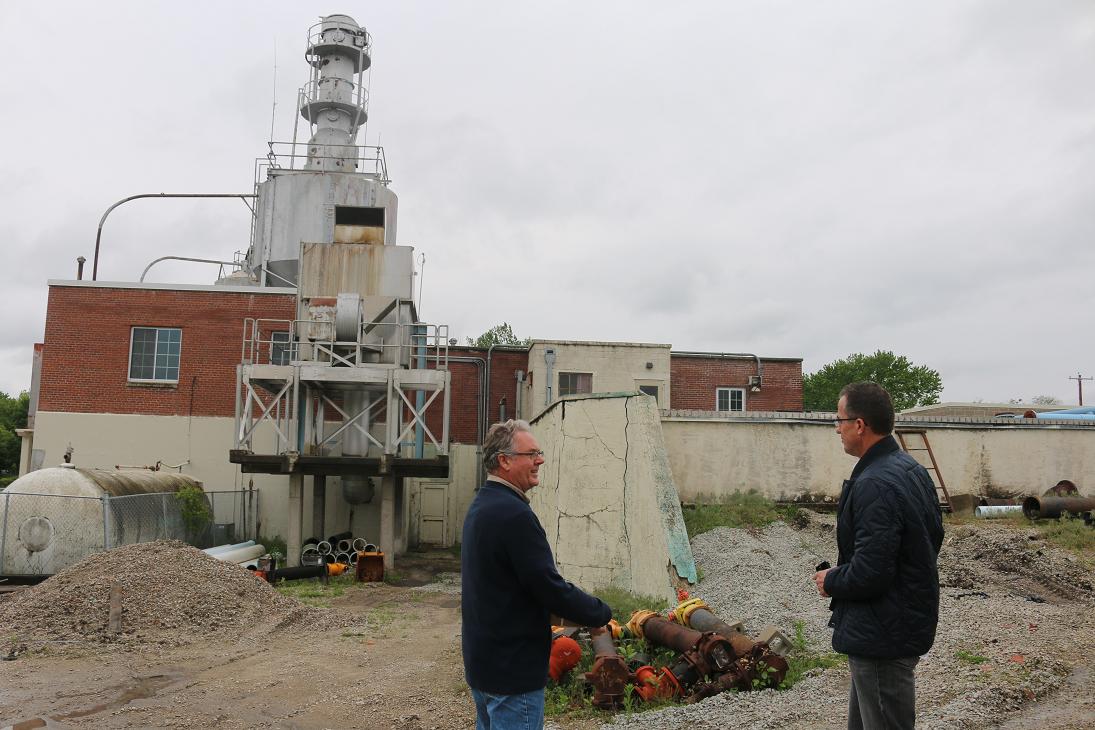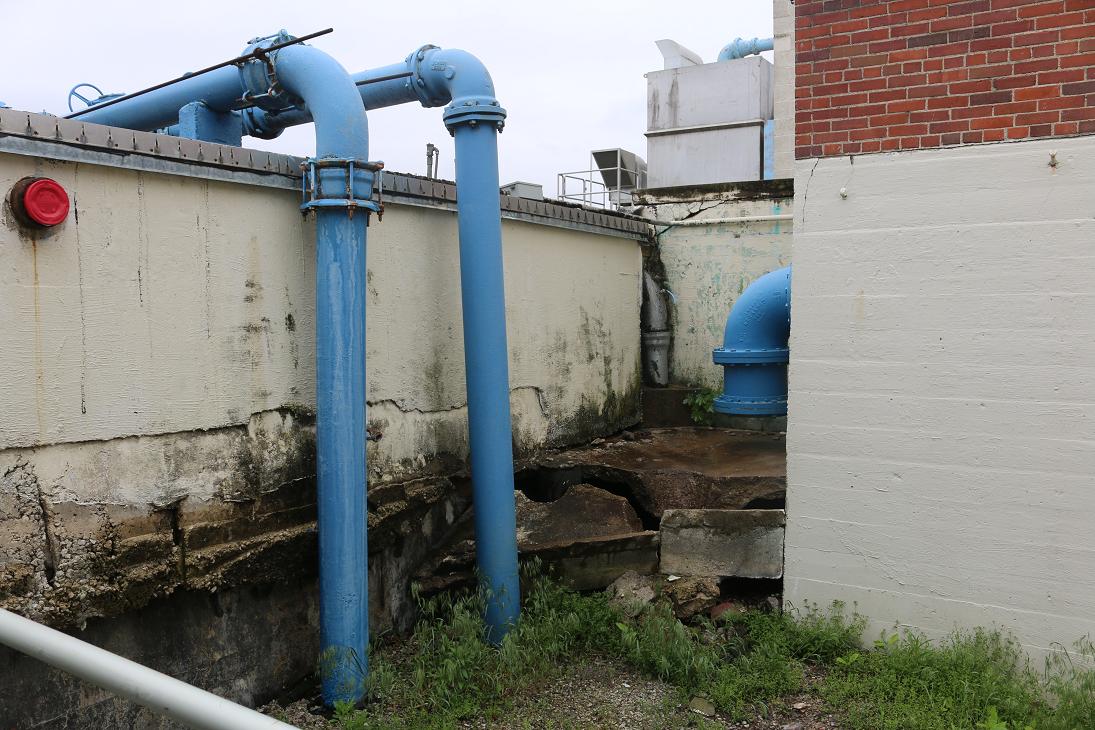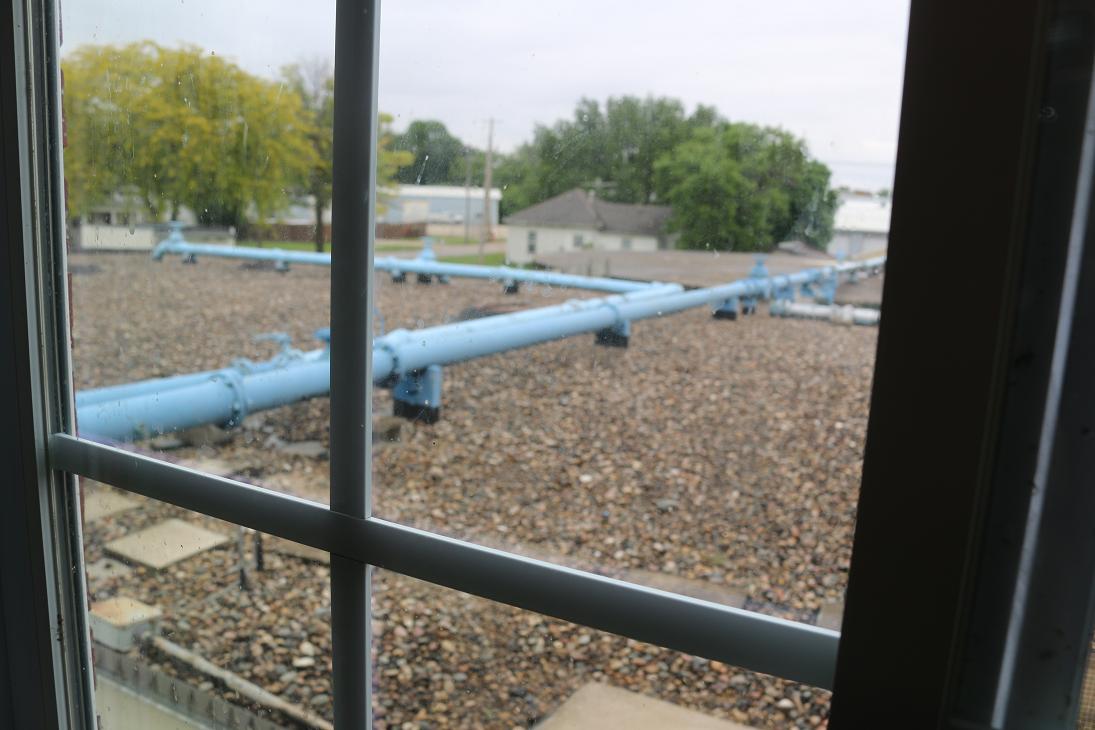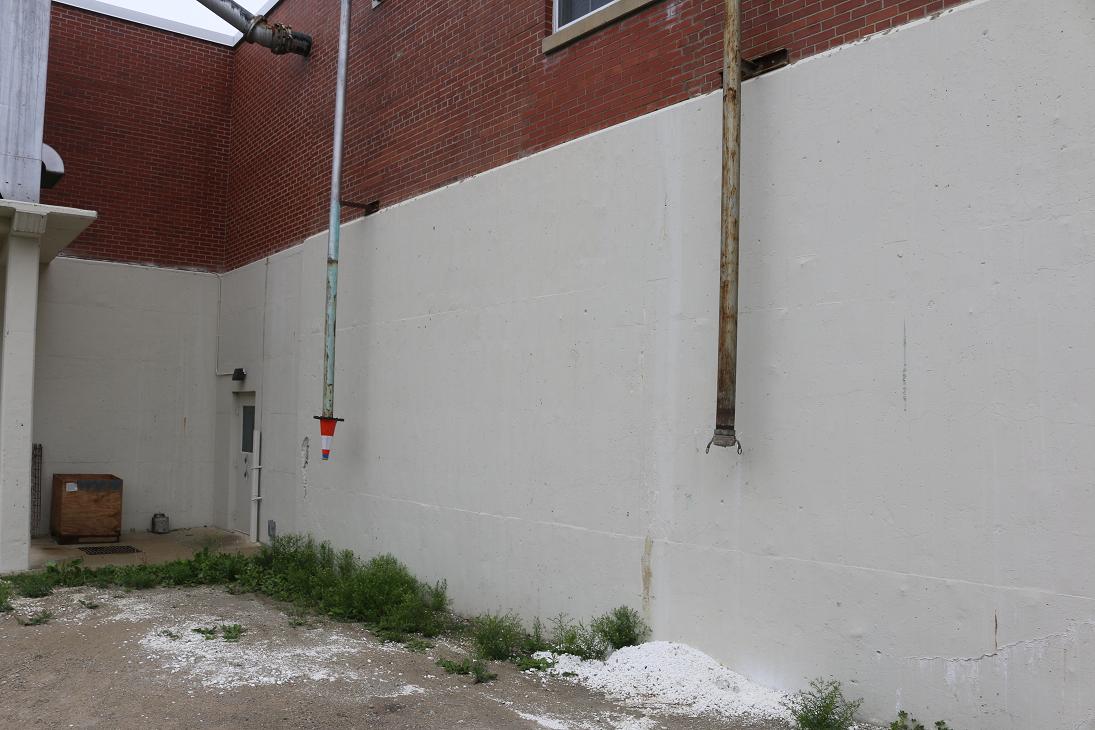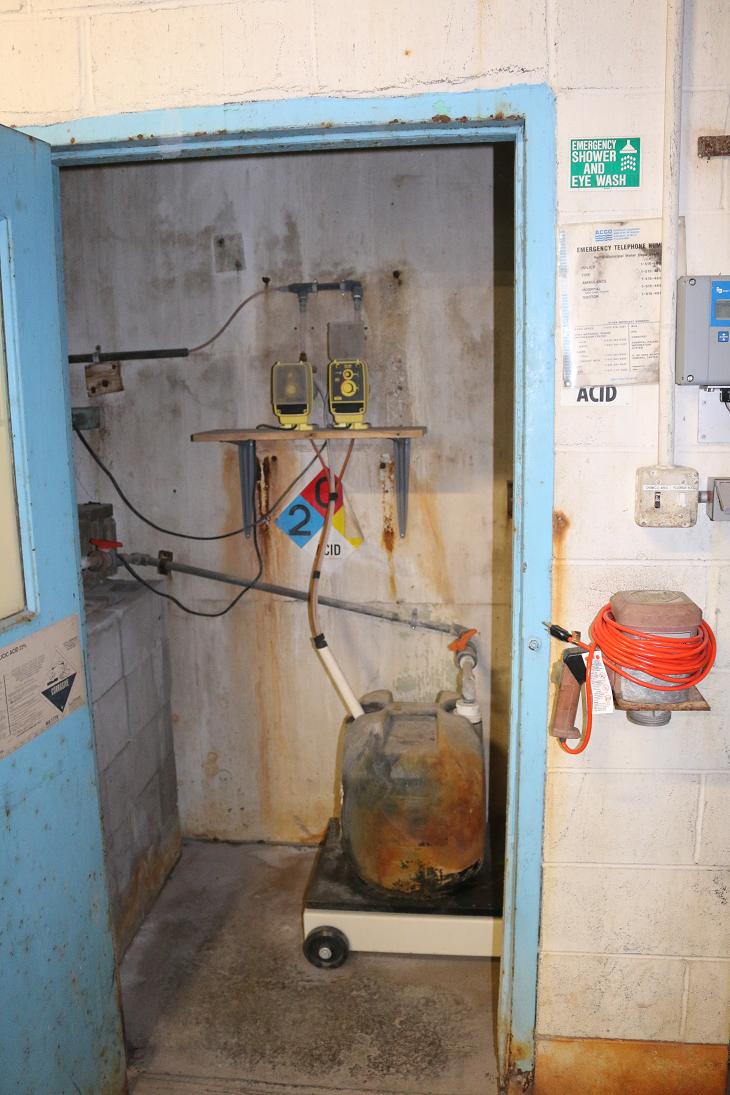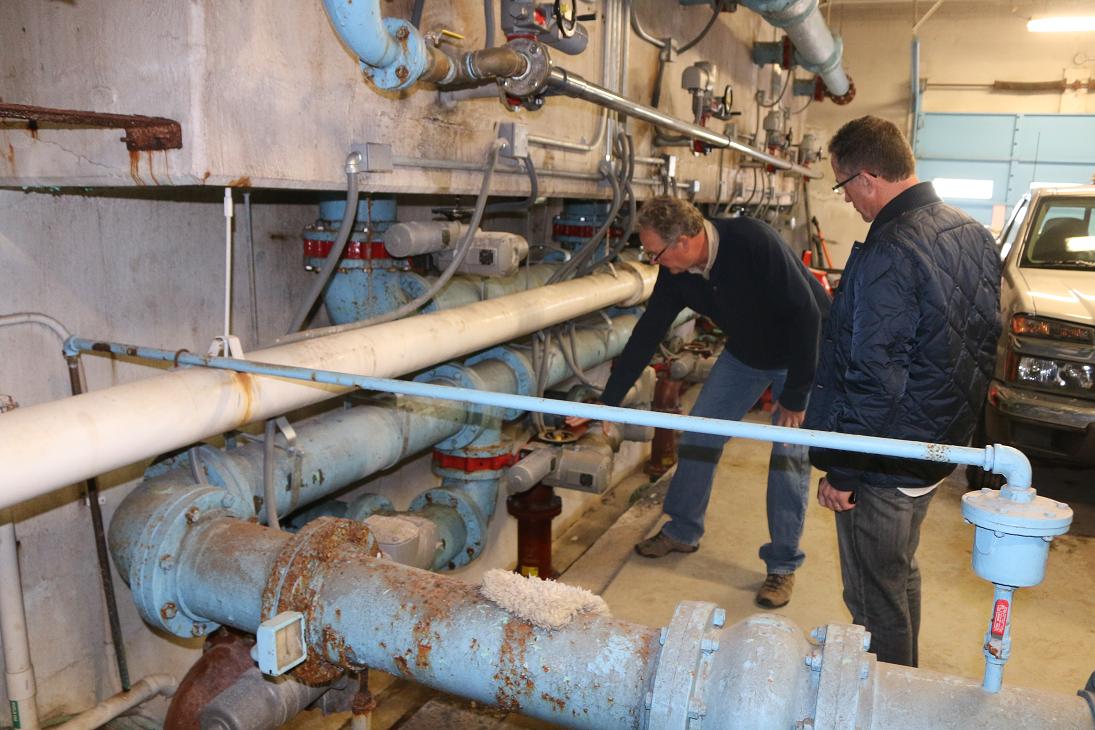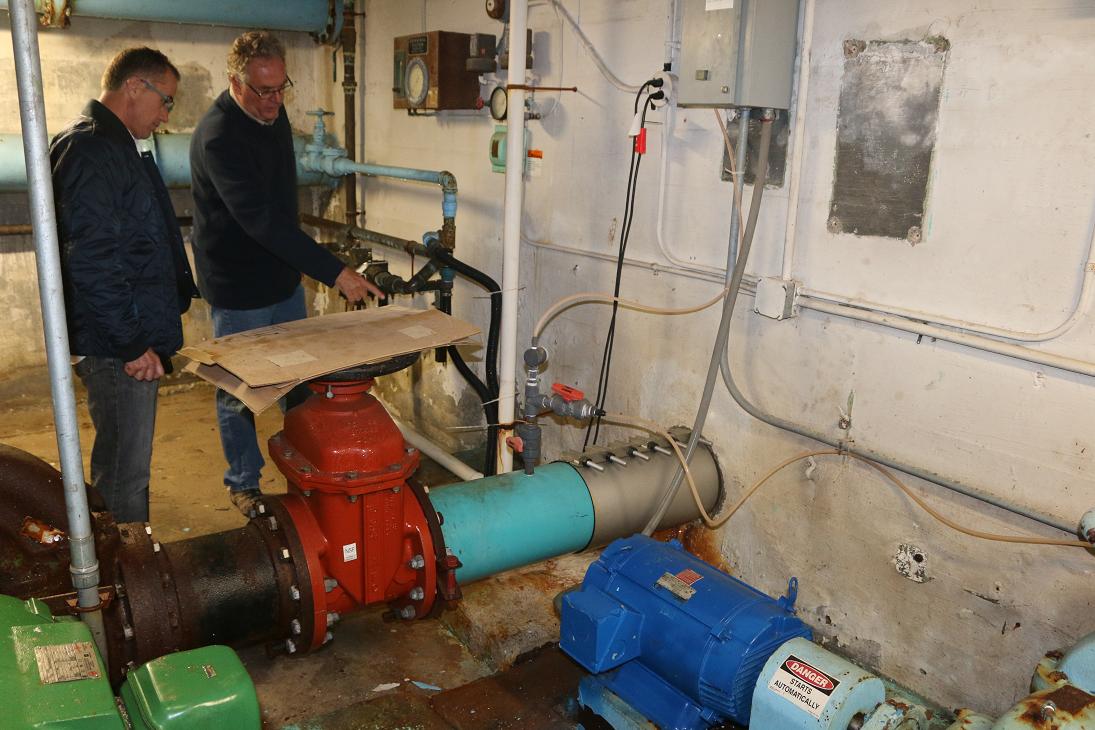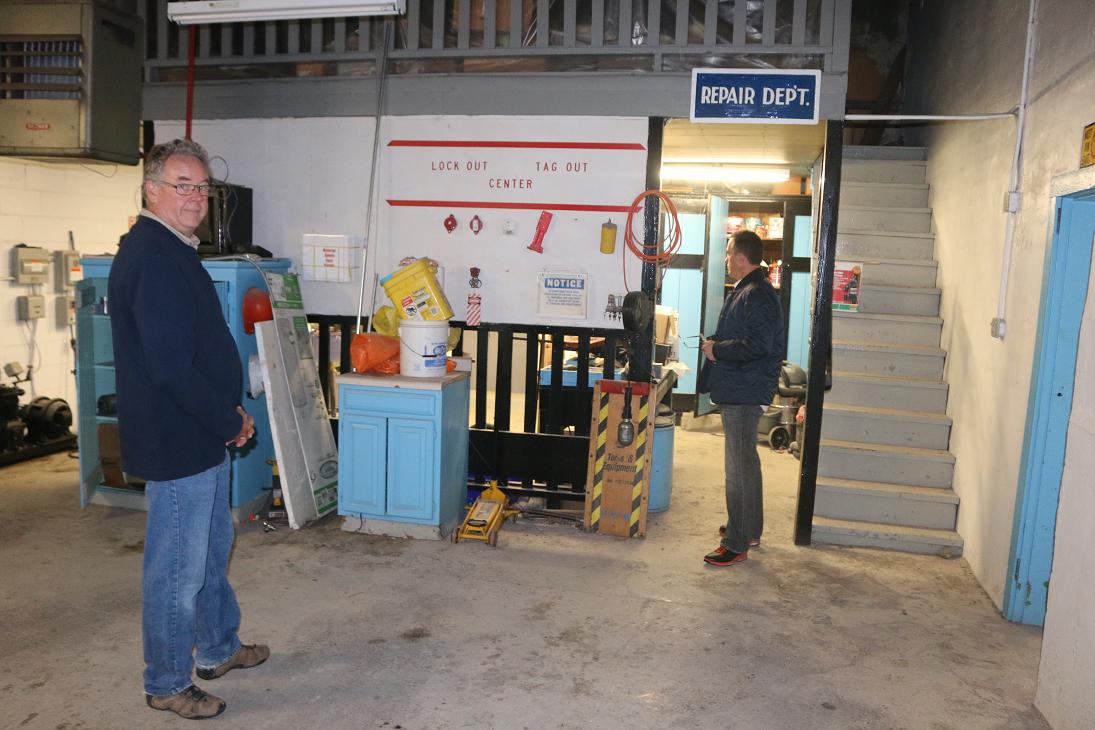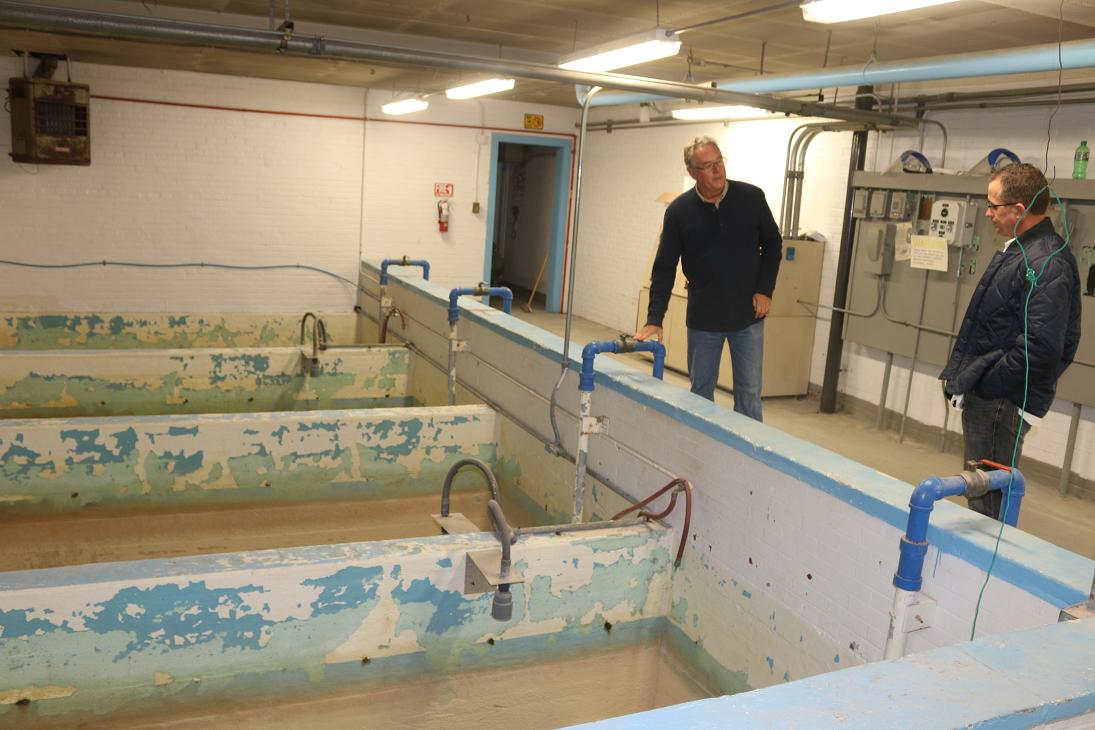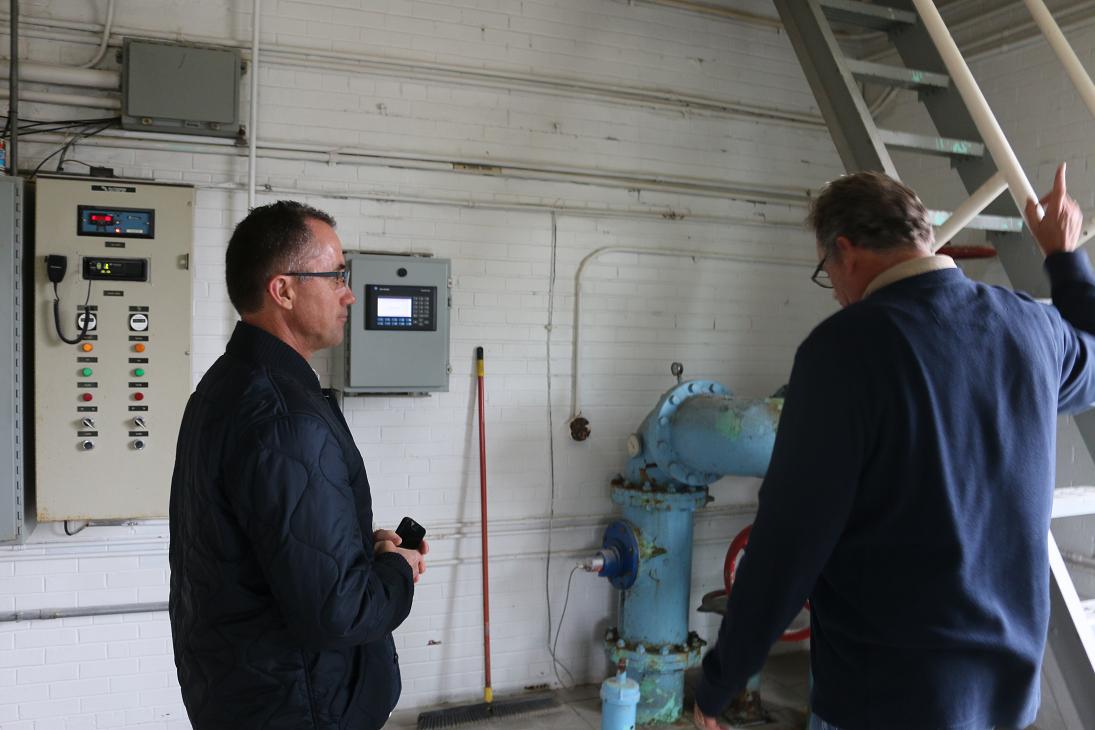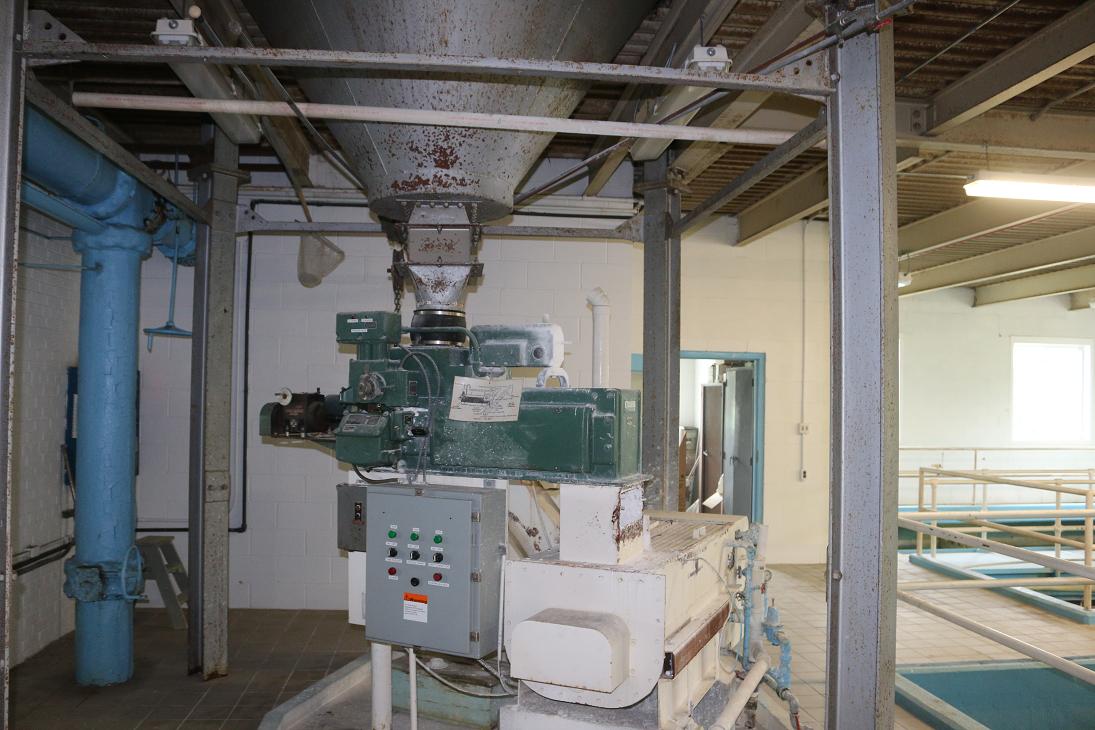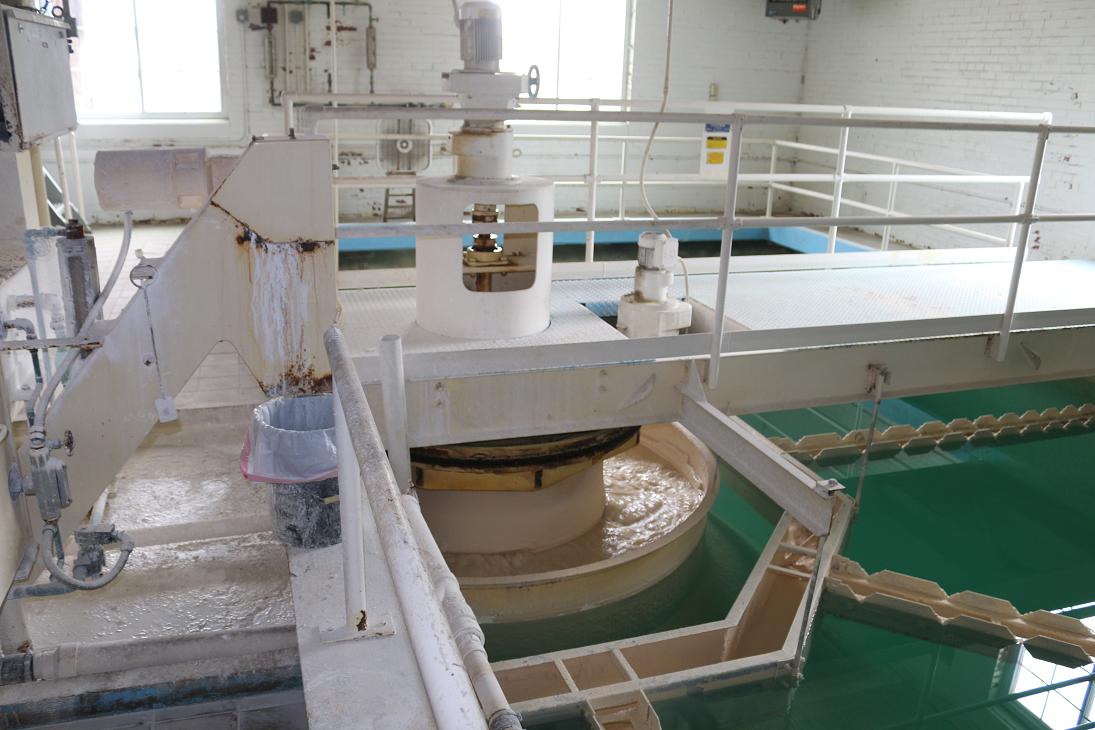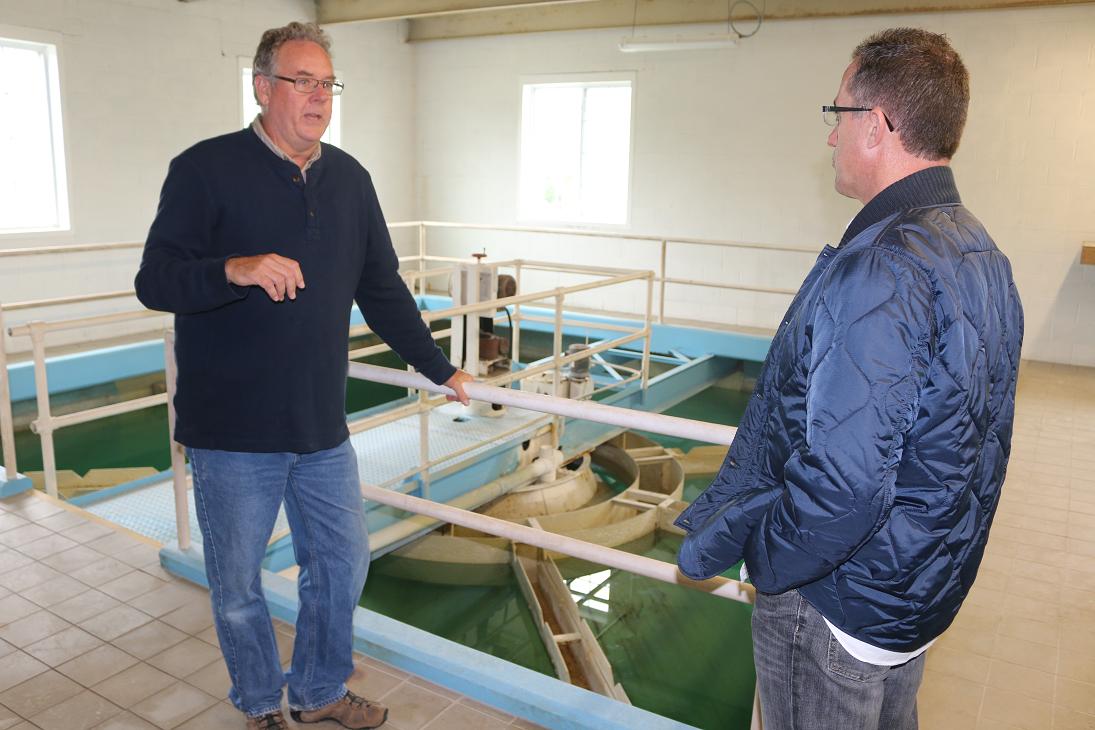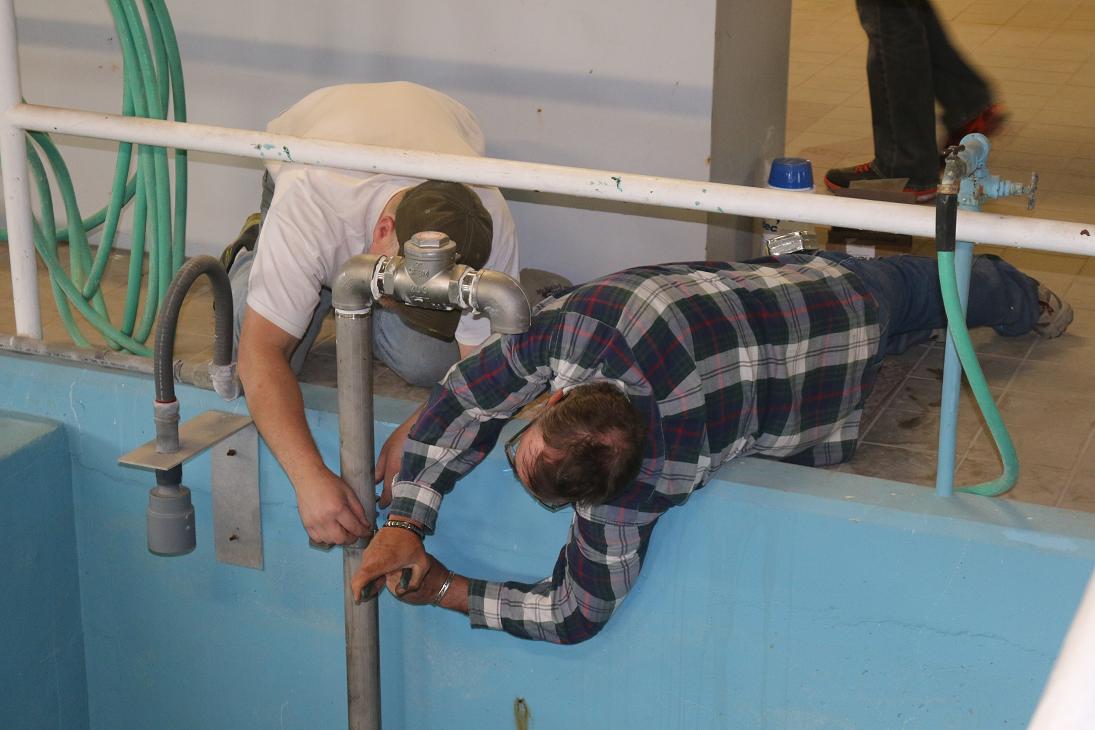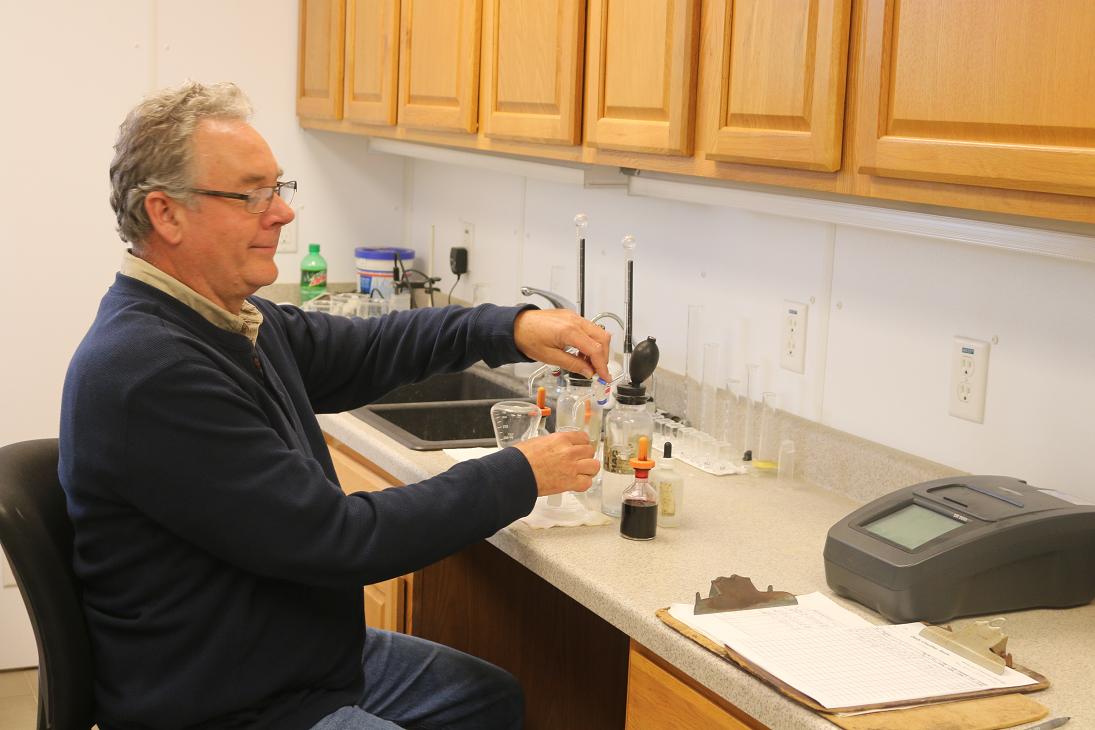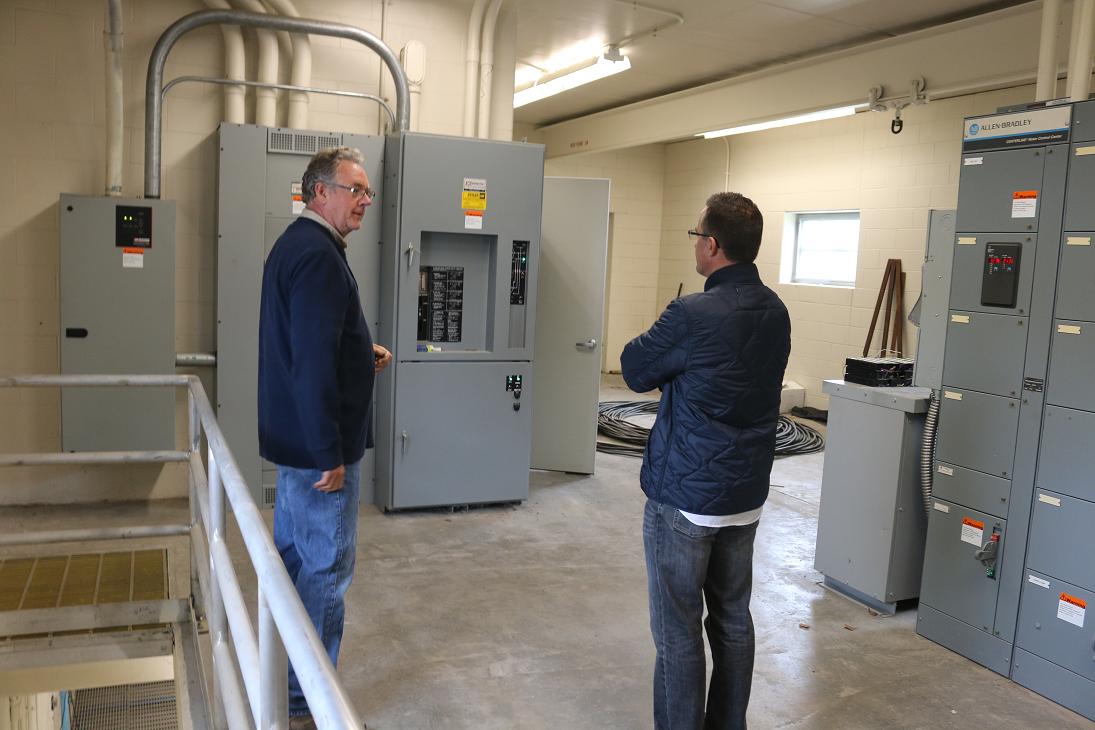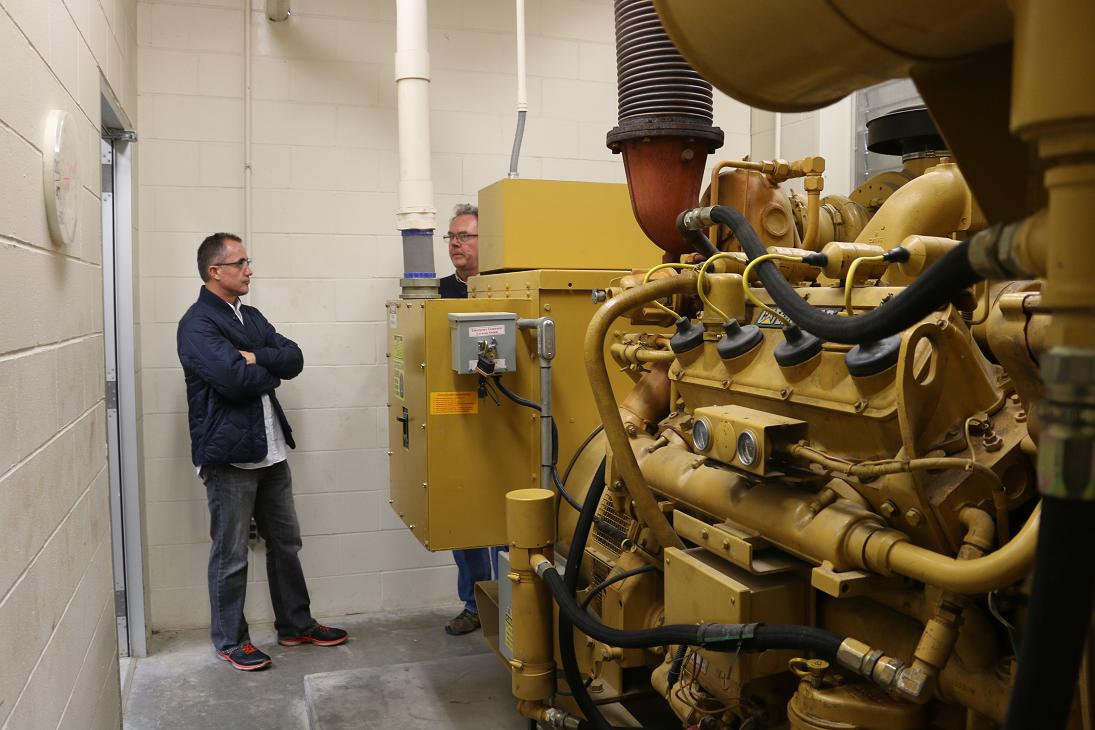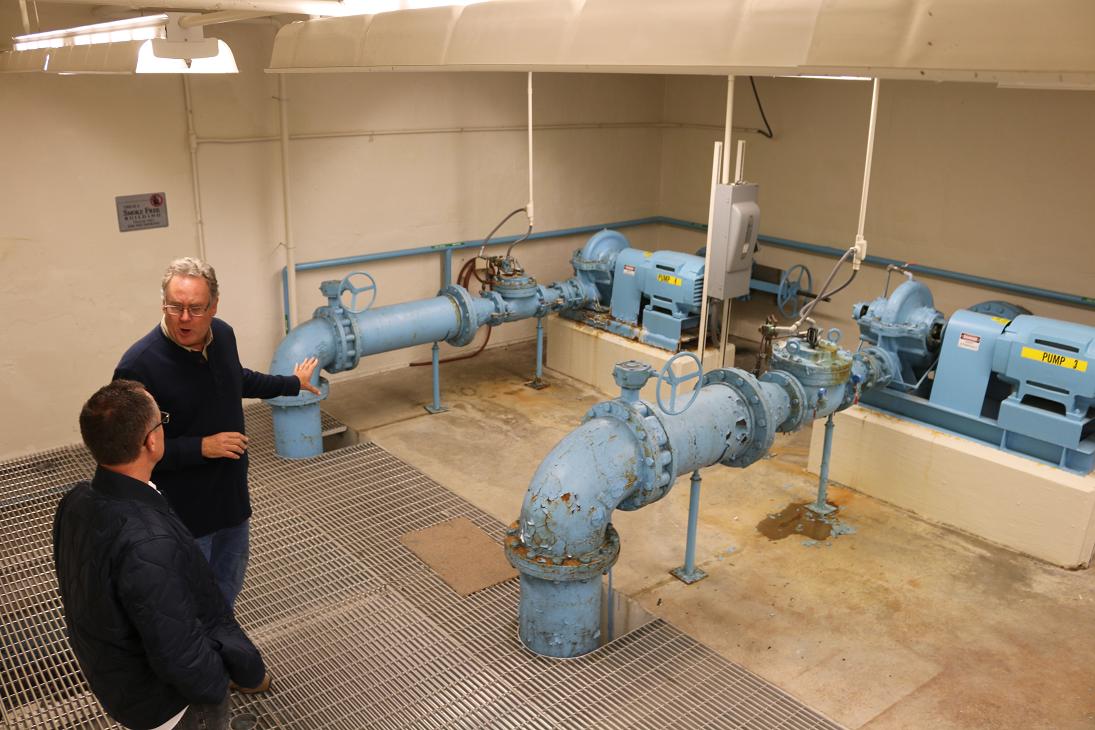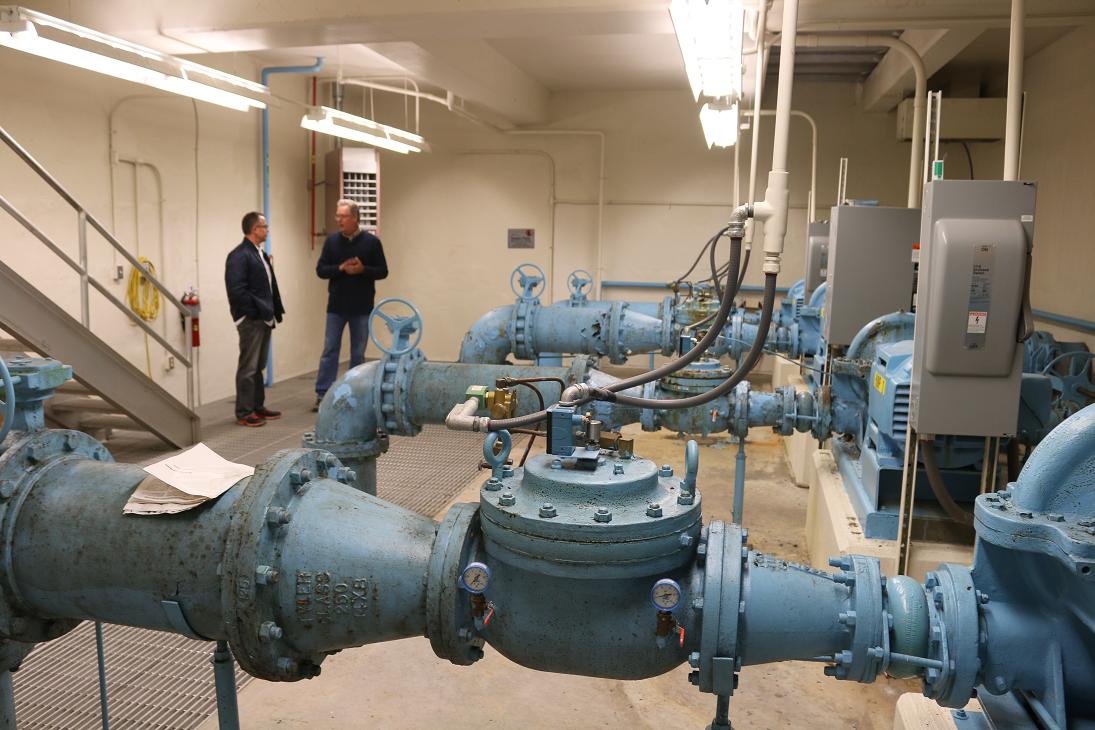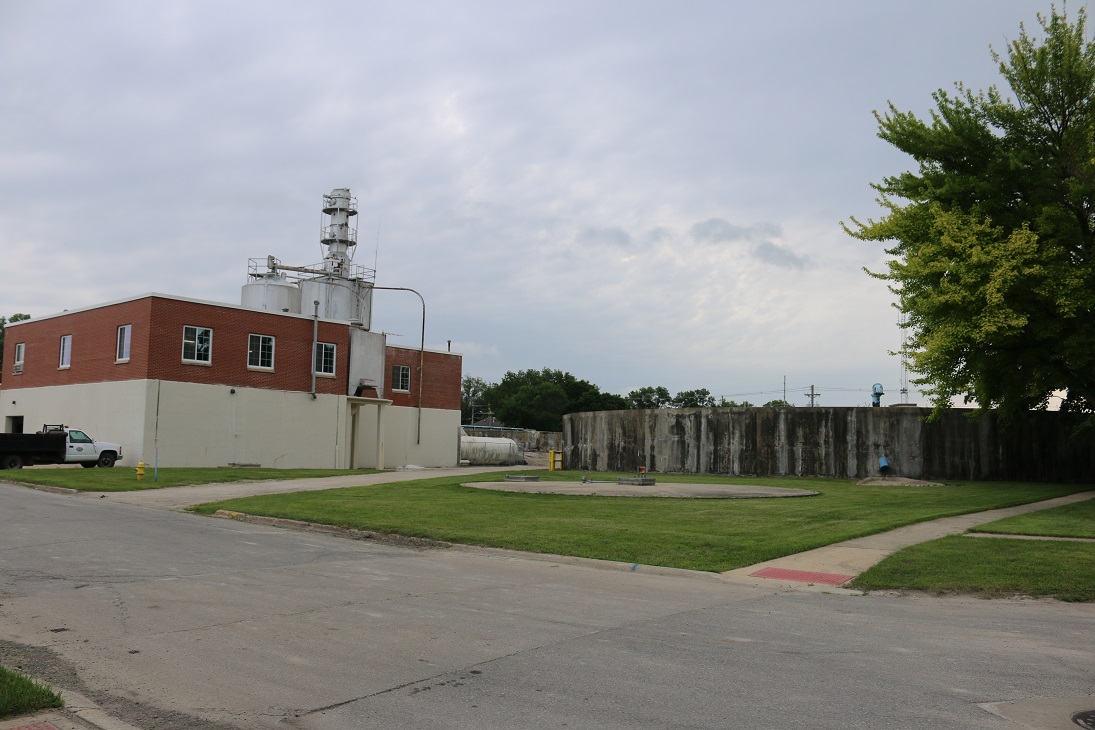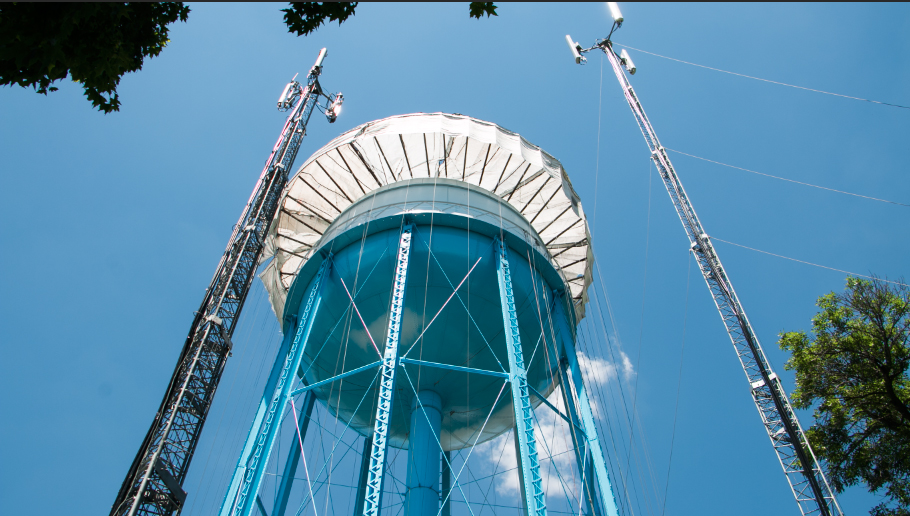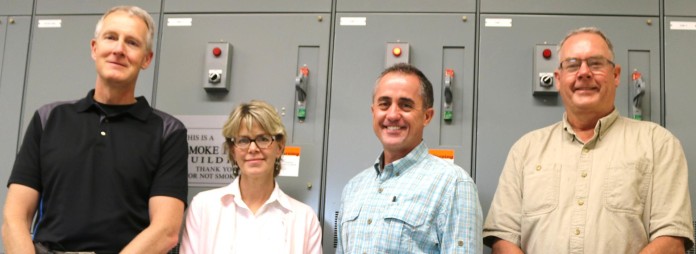
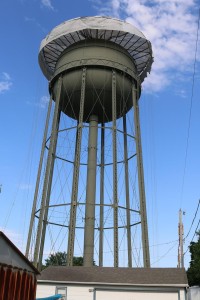
For three months this spring, a tubular skirt surrounded the water tower at Eighth and Warford streets in Perry, the plainest sign of ongoing work at the Perry Water Works. But less visible improvements to the city’s drinking water infrastructure have also been happening under the guidance of the Perry Water Works Board of Trustees and Perry Water Works Superintendent Hank Schmidt.
The water tower project involved sandblasting the surface of the tower to bare metal and then giving it three coats of fresh paint. Repainting costs were covered by a maintenance contract the Water Works has with French-owned Utility Service Co., with the work carried out by Utility Service’s Pittsburgh, Kan.-based crew.
But the maintenance contract did not cover removal and containment of the original lead-based primer paint, first applied in 1954. Chronic lead poisoning causes serious, even fatal, health effects, particularly in children. Removing and containing the environmental toxin cost the Perry Water Works $116,000, according to Schmidt, who recently outlined this and other ongoing Water Works projects for ThePerryNews.com.
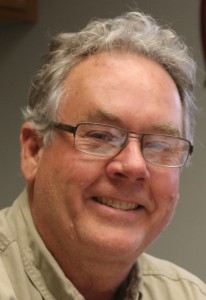
“There has been a lot of talk lately about the crumbling infrastructure nationwide,” said Schmidt, who has been the city’s water superintendent since 2012. “This is most evident in our roads and bridges because they are on the surface of the ground and very visible, but another very important area of concern is our water and wastewater infrastructure, a lot of which is buried underground. The Perry community has invested a lot of time and money in this infrastructure over the years, and maintaining these water systems is vital to our community’s health and quality of life, and the Perry Water Works has been very busy these last few years maintaining this infrastructure.”
Along with the water tower’s fresh face, Schmidt numbered the other recent improvements to the city’s water system occurring on his watch:
- Removal of waste lime from the east lime lagoon, a job done about every six to seven years,
- Replacement of the filter media in the water treatment plant’s nine filters, which returned the filters to their original design efficiency,
- Replacement of the filter valves and electric valve actuators on all nine filters,
- Replacement or upgrade of the surface wash system on all nine filters,
- Installation of a new 8-inch water main on 28th Street between Willis Avenue and McKinley Street,
- Replacement of several fire hydrants and main line valves in the distribution system,
- Repair of the treatment center’s main garage roof, which was starting to fail and in danger of collapsing. New bar joists and membrane roofing material solved the problem,
- A roof membrane replacement on the south roof of the water treatment plant and
- Lighting upgrades throughout the water plant and offices with high-efficiency lights.
This seems like a lot of work in less than three years on the job at the Perry Water Works, but Schmidt says he is happy here.
“I love it,” he said. “There’s wonderful people in Perry, and there’s plenty of challenges to keep me busy. I got into the water treatment field 30, well, going on 35 years ago now, and one of the things that really attracted me to it was it’s a community service that’s vitally important. People rely on it on a daily basis, and it can really make a difference. People don’t usually think much about it but if water professionals aren’t doing their job, then you hear about it. When things are working right, we’re more or less invisible, but we’re serving the community every day.”
“Maintaining these water systems is vital to our community’s health and quality of life.” –Hank Schmidt
Schmidt’s laundry list of projects included some that were overdue but badly needed in order to keep ahead of repairs on the city’s 100-year-old water system. But there are a few big-ticket items in the works as well, such as the $360,000 needed to repair the 500,000-gallon concrete reservoir at the treatment plant.
“That’s a third to a half the cost of tearing it down and building a new one,” Schmidt said, “so we’re going to save that tank, if we can, by lining it and then sealing the outside and doing some concrete repairs on it.”
The concrete water tank leaks, so Utility Service Co. will install an interior lining and patch the exterior cracks with epoxy paint, along with some other concrete repair. A new tank would cost between $1 million and $1.5 million, Schmidt said.
“It was a tough decision,” he said, “because it’s almost too far gone, but we think we can save it, and it will cost quite a bit less than putting a brand new one in.”
Another large item in this year’s budget is called the lime descant project. When the quicklime the city uses to soften its well water exhausts its usefulness, it is pumped, in the form of lime sludge, to lime lagoons on the city’s southwest boundary. There the lime particles slowly settle to the bottom of the lagoon, leaving clear water on top.
The Perry Water Works has a permit from the DNR allowing it to discharge the clear water, called descant, into the Raccoon River. As Schmidt explained, although the descant is clean enough to go into the river in terms of its suspended solids, new DNR rules taking effect this year declare the water’s pH to be too high for direct discharge. The lime has left it too basic.
As a result, Water Works will start redirecting its lagoon descant to the city’s nearby wastewater treatment plant. The diversion will be accomplished by pumping the clear water from the lagoons to the wastewater facility, and the pump and associated lines will cost about $350,000.
Several other capital expenses in the current fiscal year’s budget are also notable. A number of fire hydrants and main line valves will be replaced at an estimated cost of $20,000, according to Schmidt, and some service lines along north First Avenue will be moved from an old water main that often breaks to a newer one. The price tag for the improvement is about $25,000.
Our municipal water works
Capital projects like these, along with other financial matters, are handled by the three-person Perry Water Works Board of Trustees, which manages the overall operation of the water department. Schmidt oversees the day-to-day operations of the system and advises the trustees on technical questions.
The board of trustees is currently chaired by Marcus Carris, with Amy Rathje and Lonnie Ostransky rounding out the board. Schmidt is the superintendent, Pam Ballard the Perry Water Works secretary and Mark Powell provides the trustees with legal counsel.
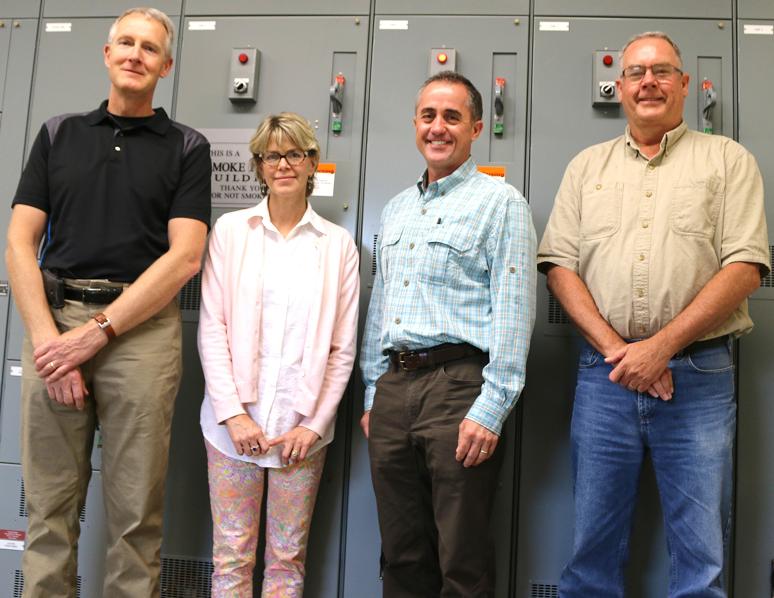
In 2014 the Perry Water Works took in about $1.85 million, mostly in fees from water customers, and it spent $1.23 million on operations. It carried a cash balance of about $730,000, which is used to fund the kind of capital expenses Schmidt listed.
The Tyson Fresh Meats pork processing plant near Perry is the city’s biggest water consumer, Schmidt said, buying anywhere from 25 percent to 35 percent of the city’s monthly water production and contributing 30 percent to 40 percent of the Perry Water Works monthly revenues.
Schmidt has a talent for explaining complicated matters in a way that reporters and other ignorant laypeople can easily grasp. He summarized the process of turning well water into drinkable water:
“Ground water is pumped from a combination of our wells,” he said. “We have 13 wells altogether, ranging in production from about 70 gallons per minute to about 600 gallons per minute. Each well differs slightly from the others in its chemistry.
“Perry’s well water is of high quality except for hardness and ammonia, with small amounts of iron and manganese. Only trace amounts of nitrate and/or nitrite are found in Perry’s well water. The wells are all piped to send the water to the water treatment plant.
“At the plant the water first passes through an aerator to oxidize the iron and manganese so that it can be removed through the treatment process.
“Next the water enters one of the two clarifiers, where alum and lime are added to remove hardness and aid in settling of solids, which are mostly calcium hardness, iron and manganese precipitates.
“From the clarifier, the water then passes through the carbon dioxide chamber, where CO2 is bubbled through the water to stabilize the pH. The water next enters the chlorine contact chamber, where chlorine is added as a disinfectant.
“From there, the water passes through the filters to remove any remaining solids. The final step is the clear-well, where fluoride is added to bring the fluoride level to the optimum level of 0.7 parts per million for prevention of tooth decay.
“The high-service pumps then move the water from the clear-well to the concrete storage tanks of 1 million gallons and 500,000 gallons. Water is also pumped to the elevated storage tank as needed by the finished-water pump station.”
Flowing forward
As the city’s water infrastructure ages, its lifespan can be extended through regular maintenance, Schmidt said, such as continued replacement of fire hydrants and main line valves as needed and replacement of undersized and aging water mains around town.
“Perry is not different than every other city in America as far as crumbling infrastructure,” Schmidt said. “A lot of money was invested over the years as cities built up, and Perry’s fairly old, but it’s just a big problem, and we need to start investing in our infrastructure again. And in my opinion it should be local money. When you get federal money, it costs a lot more.”
While Perry has been fairly stable in terms of its size for several generations, a period of sustained growth and development cannot be ruled out. For this reason, public utilities such as the Perry Water Works also keep long-term projects in view.
“As growth occurs,” Schmidt said, “we will need to build the infrastructure to meet the expanded needs of the community. This could include new water mains and a second elevated water tower.”
While maintenance is crucial, Schmidt said, the 80-year-old water treatment facility will eventually need to be replaced, probably within the next 15 to 20 years.
“A new treatment plant could cost between $7 million to $12 million,” he said, “and it would be good if we have at least 10 percent to 20 percent of that money in the bank at that time.”
In the here and now, providing Perry residents with high-quality drinking water is the mission of Perry Water Works. By all measures, such as the 2014 Consumer Confidence Report, they are succeeding.








